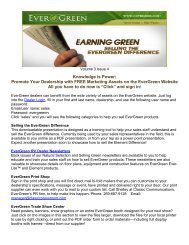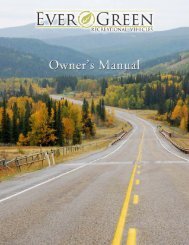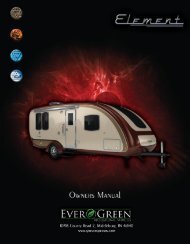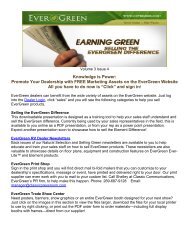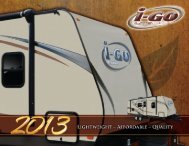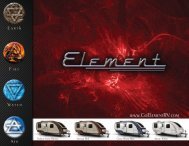EverGreen Owner's Manual
EverGreen Owner's Manual
EverGreen Owner's Manual
You also want an ePaper? Increase the reach of your titles
YUMPU automatically turns print PDFs into web optimized ePapers that Google loves.
EXIT WINDOW<br />
Dependent upon your specific floor plan configuration, your RV will be equipped with exit or egress<br />
window(s). These windows have an “exit” label directly adjacent to the window and are also easily<br />
recognizable by the interior handles or latches which are red in color. These windows are designed to<br />
allow emergency exit of the occupants in the event of a fire or similar occurrence. To open, rotate the<br />
handles inward and then pivot the window and glass outward on the top hinge. Review the exit window<br />
operation and location with all passengers prior to each trip.<br />
Please use extreme caution when using any propane appliance and when attaching or detaching<br />
the propane bottles from the RV. Improper handling of propane and propane system may result<br />
in serious injury or death.<br />
PROPANE SAFETY<br />
• The gas system in your RV is designed for use with Propane (LPG) gases only, do not use or connect to natural gas.<br />
• Do not smoke cigarette, pipes, or cigars, or provide any open flame in the general area of the propane tanks when<br />
attaching/detaching the tanks.<br />
• Propane tanks may only be filled by trained personnel in accordance with NFPA Pamphlet 58, and all local or state<br />
codes and regulations.<br />
• Remain at least 30 feet away from the propane filling station during the filling process.<br />
• Do not allow the propane tanks to be filled to more than 80% capacity.<br />
• Do not use cooking appliances for comfort heating.<br />
• Cooking appliances need fresh air for safe operation. Open window or vent prior to operating propane supplied<br />
stove or range. Failure to provide adequate fresh air supply can result in elevated carbon monoxide levels and<br />
asphyxiation.<br />
• If at any time you smell propane;<br />
1. Immediately extinguish all smoking materials, open flames, and pilot lights.<br />
2. Do not touch any electrical switches or components as arcing may occur.<br />
3. Shut off the gas supply at the propane tank by turning the valve clockwise.<br />
4. Open all entry doors and windows.<br />
5. Do not use the power range hood or power roof vents.<br />
6. Clear the area until the propane odor is no longer apparent.<br />
7. Have the propane systems checked prior to again using the propane system.<br />
• Do not store, transport or place propane cylinders inside the RV.<br />
• Verify all appliances and appliance gas valves are turned off prior to opening the main valve on the main propane<br />
supply tanks.<br />
• Verify the propane regulator vent is clear and free of obstruction.<br />
• Do not modify the factory installed propane system.<br />
• Maintenance of the propane system is only to be performed by personnel qualified and trained in propane gas<br />
systems.<br />
• Verify each month that burners and orifices of the propane appliances are clean and free of obstructions. Note;<br />
certain insects such as wasps, can build nests in the burner tubes of the appliances. These systems should be<br />
checked at a repair facility at least yearly and any time the appliance appears to be burning improperly.<br />
• Never use a flame to check for propane leaks.<br />
• Unless trained and certified, do not attempt adjustment of a propane regulator or adjustment of a propane appliance.<br />
• The hose from the regulator must be capped when removing the propane cylinder.<br />
• Always extinguish all pilots, gas fired appliances and turn off the main LP supply valve at the supply tank prior to<br />
pulling into a propane or gasoline fill station.<br />
17




